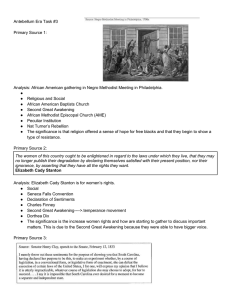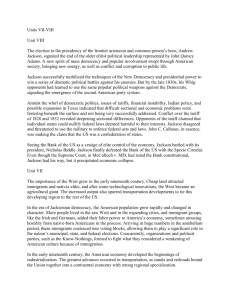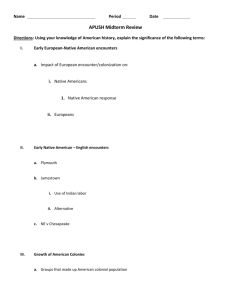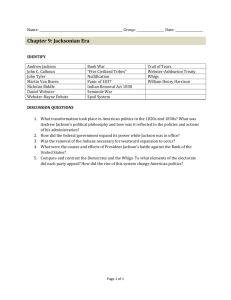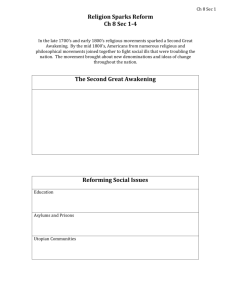Period 4: 1800-1848: (Chapters 11-17: The American Pageant, 15th
advertisement
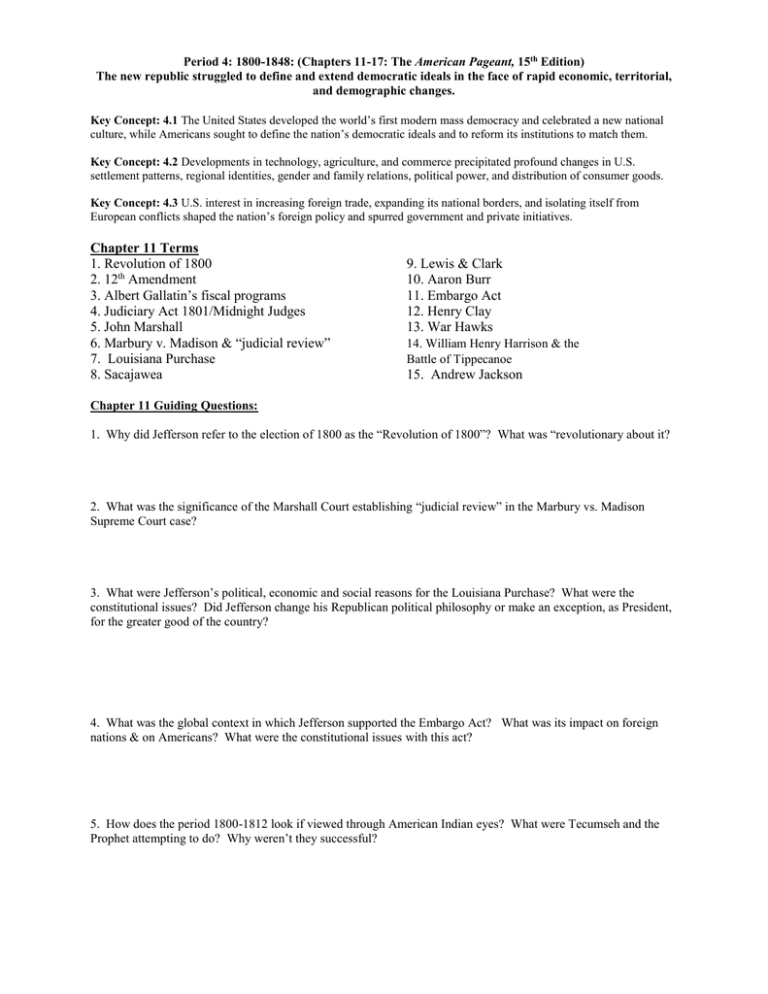
Period 4: 1800-1848: (Chapters 11-17: The American Pageant, 15th Edition) The new republic struggled to define and extend democratic ideals in the face of rapid economic, territorial, and demographic changes. Key Concept: 4.1 The United States developed the world’s first modern mass democracy and celebrated a new national culture, while Americans sought to define the nation’s democratic ideals and to reform its institutions to match them. Key Concept: 4.2 Developments in technology, agriculture, and commerce precipitated profound changes in U.S. settlement patterns, regional identities, gender and family relations, political power, and distribution of consumer goods. Key Concept: 4.3 U.S. interest in increasing foreign trade, expanding its national borders, and isolating itself from European conflicts shaped the nation’s foreign policy and spurred government and private initiatives. Chapter 11 Terms 1. Revolution of 1800 2. 12th Amendment 3. Albert Gallatin’s fiscal programs 4. Judiciary Act 1801/Midnight Judges 5. John Marshall 6. Marbury v. Madison & “judicial review” 7. Louisiana Purchase 8. Sacajawea 9. Lewis & Clark 10. Aaron Burr 11. Embargo Act 12. Henry Clay 13. War Hawks 14. William Henry Harrison & the Battle of Tippecanoe 15. Andrew Jackson Chapter 11 Guiding Questions: 1. Why did Jefferson refer to the election of 1800 as the “Revolution of 1800”? What was “revolutionary about it? 2. What was the significance of the Marshall Court establishing “judicial review” in the Marbury vs. Madison Supreme Court case? 3. What were Jefferson’s political, economic and social reasons for the Louisiana Purchase? What were the constitutional issues? Did Jefferson change his Republican political philosophy or make an exception, as President, for the greater good of the country? 4. What was the global context in which Jefferson supported the Embargo Act? What was its impact on foreign nations & on Americans? What were the constitutional issues with this act? 5. How does the period 1800-1812 look if viewed through American Indian eyes? What were Tecumseh and the Prophet attempting to do? Why weren’t they successful? Chapter 12 Terms 1. War of 1812 (causes) 2. Battle of New Orleans 3. Treaty of Ghent 4. Hartford Convention 5. Era of Good Feelings 6. Growing Sectionalism 7. John Calhoun 8. Daniel Webster 9. Henry Clay 10. American System 11. Internal Improvements (Controversies?) 12. 2nd Bank of the United States 13. Tallmadge Amendment 14. Missouri Compromise 15. Andrew Jackson 16. James Monroe 17. John Quincy Adams 18. Tariff of 1816 19. Monroe Doctrine 20. John Marshall Cases: Fletcher v. Peck, Cohens v. Virginia, Dartmouth College v. Woodward, McCulloch v. Maryland, Gibbons v. Ogden (See Handout) Chapter 12 Guiding Questions: 1. Was the War of 1812 avoidable or necessary to establish respect for the still new United States of America? 2. How unified were Americans during the War of 1812? Compare and contrast this unity to that during the Revolutionary War. 3. What was behind the strong spirit of nationalism that appeared from 1815-1824? What things came out of this wave of nationalism? 4. What kinds of tensions were simmering underneath the surface of the “Era of Good Feelings”? 5. What were the provisions of the Missouri Compromise? Did the Missouri Compromise effectively deal with the sectional conflict over slavery or merely put a band-aid on the issue? 5. Did the Supreme Court decisions under John Marshall’s leadership extend federal power too much? Should a non-elected Supreme Court Chief Justice have such tremendous power to shape the government and the law? Is it appropriate that a political party’s ideology be implemented through the judiciary? Is this happening today? Examples? 6. Was the Monroe Doctrine a valuable assertion of the principles of liberty and self-determination in the Americas against intrusion by European colonial powers, or was it an early manifestation of patronizing and potentially imperialistic attitude by the United States toward Latin American nations? 7. Did the Monroe Doctrine build upon the isolationist tradition set in motion by George Washington’s Neutrality Proclamation and Farewell Address? Chapter 13 Terms 1. “Corrupt Bargain” 2. Universal white male suffrage 3. New Democracy & the common man 4. Tariff of Abominations & the nullification crisis 5. John Calhoun’s S. Carolina Exposition & Protest 6. Spoils System vs. Rotation of Office 7. Andrew Jackson “King Andrew” 8. Martin Van Buren 9. Tariff of 1832 & 1833 10. Force Bill 11. Bank Veto 1832 12. Specie circular & the Panic of 1837 13. Cherokee Nation v. Georgia 14. Worchester v Georgia 15. Trail or Tears 16. Stephen Austin 17. Sam Houston & Texan War for Independence 18. Conflict over the admission of Texas 19. Whigs 20. Old Tippecanoe & the Log Cabin Campaign Chapter 13 Guiding Questions: 1. What were the advantages and disadvantages of the new politics of mass democracy? Who benefitted? Who was left out of the “new democracy”? 2. Why were tariffs such a dividing issue in the 1820’s and 30’s? 3. Which side fared better as a result of the nullification crisis: the national government (and federal supremacy) or South Carolina (and states’ rights)? Why? 4. To what extend did Andrew Jackson change the balance of power between the three branches of government? Did he dramatically expand the power of the executive branch? 5. How was Andrew Jackson able to win the “Bank War” and destroy the Second Bank of the United States? 6. Who were the Whigs and what did they stand for & against? Why did their appearance on the American political scene mark the end of the Era of Good Feelings and the beginning of the second party system in America? 7. What were the causes and consequences of the Texas revolt? Why did Texas remain for a time and independent nation rather than quickly become a state of the Union? 8. In what ways did the Missouri Compromise and Texan independence usher in an era of conflict that would ultimately lead to the Civil War? Chapter 14 Terms 1. Immigration Push/ Pull factors 2. Nativism 3. Known Nothings – the American Party 4. Samuel Slater 9. Separate Spheres 10. McCormick Mower-Reaper 11. National Road/ Cumberland Road 12. Erie Canal 5. Eli Whitney’s Cotton Gin & Interchangeable parts 13. Clippers Ships 6. Commonwealth v. Hunt 14. Pony Express 7. Lowell System/Lowell Mill Girls 15. Transatlantic Telegraph Cable 8. Cult of Domesticity 16. Early Railroads 17. John Deere’s Steel Plow Chapter 14 Guiding Questions: 1. Consider the Irish and Germans. What were some key factors that pushed these immigrants out of their homelands? What factors pulled them toward the United States? 2. Why was transportation – such as roads, canals and railroads – so important in the early stages of industrialization and American economic development? Would industrialization have occurred more quickly if there hadn’t been constitutional issues over federal financial assistance for internal improvements? 3. Which technological innovation was most important for early-nineteenth-century economic development? Why? 4. Compare the life of a factory worker to that of slaves in the South. Is “wage slave” an appropriate description for factory workers? 5. In what ways did the Lowell Mill Girls challenge the “cult of domesticity”? 6. What effects did the movement from subsistence to a market economy have on American society, including farmers, laborers, and women? What were the pros and cons? Chapter 15 Terms 1. The 2nd Great Awakening 2. Burned over District 3. Charles Grandison Finney 4. Mormons/Joseph Smith/Brigham Young 5. Reform movements 6. Horace Mann 7. Noah Webster 8. Female Seminaries 9. Oberlin College 10. Dorothea Dix 11. American Temperance Society 12. Maine Law 13. Lucretia Mott 14. Elizabeth Cady Stanton 15. Susan B. Anthony 16. Dr. Elizabeth Blackwell 17. Seneca Falls Convention/Declaration of the Sentiments 18. Utopian Communities (Shakers, Oneida, etc.) 19. Hudson River School of Painting 20. See Literature Handout for Transcendentalism & Authors: (Irving, Fenimore Cooper, Emerson, Thoreau, Whitman, Dickenson, Hawthorne, Poe, etc.) Chapter 15 Guiding Questions: 1. How did Evangelical religion influence American culture? Why did it inspire so many reform movements? 2. What other factors inspired the reform movements of the early 19 th century? Why then? 3. Which reform movements were inspired by fear, xenophobia or concerns about the direction of America? 4. Which ones aimed at the expansion of democratic ideals such as voting rights, life, liberty and the pursuit of happiness? 5. How important is free public education to a republic? Explain your answer. 6. Why did women play such an important role in so many reform movements? 7. What obstacles & limitations did women face at this time? What did the women’s rights movement & the Seneca Falls Convention hope to achieve for the status of women in American society? 8. What had changed, regarding the Abolitionism movement in the 1830’s, with the publishing of Garrison’s the Liberator? (See chapter 17 section on abolitionism.) 9. Why so many utopian movements? What did they contribute to American culture? 10. If you were living in the early 19th century, which reform movement(s) would you have supported? Why? Chapter 16 Terms 1. King cotton 2. “Peculiar institution” 3. Gabriel’s Rebellion 4. Denmark Vesey & Nat Turner Slave Rebellions 5. American Colonization Society 6. Theodore Dwight Weld 7. Angelina and Sarah Grimké 8. William Lloyd Garrison/ “The Liberator” 9. American Anti-Slavery Society 10. David Walker 11. Sojourner Truth 12. Frederick Douglass 13. Gag-Resolution 14. Reverend Elijah P. Lovejoy Chapter 16 Guiding Questions: 1. How did slavery affect white Southern Society – including those who owned slaves & those who did not? 2. How did it affect both the slave and the slave owner? 3. How did blacks respond the condition of slavery? 4. Why did Thomas Jefferson say, “With slavery, we have a wolf by the ears, and we can neither hold him nor safely let him go”? 5. Why did the South move from slavery as a “necessary evil” to proclaiming it a positive good? 6. How had the U.S. Constitution contribute to the controversy over slavery? How could both slavery advocates and abolitionists use the Constitution to support their viewpoints? Be specific. 7. How effective were the abolitionist movements? How did they affect American society and politics? 7. What divisions existed among abolitionists? 7. Did the gag rule & restrictions on abolitionist literature in the U.S. mail violate basic Constitutional freedoms? Were they justified at the time? Chapter 17 Terms 1. John Tyler/ “His Accidency” 2. Webster-Ashburton Treaty, 1842 3. Lone Star Republic 1836 Texas annexation, 1845 4. “Conscience Whigs” 5. Settling the Oregon Dispute/”54 40 or fight!” 6. Manifest Destiny 7. California Missions/Californios 8. Liberty Party 9. James Polk & his 4-point program 10. Zachary Taylor 11. Abraham Lincoln’s “spot” resolutions 12. Mexican-American War (causes) 13. John C. Fremont & the Bear Flag Republic 14. Winfield Scott 15. Wilmot Proviso 16. Treaty of Guadalupe Hidalgo Chapter 17 Guiding Questions: 1. Was American expansion across North America an “inevitable” development? How was the idea of Manifest Destiny used to justify expansionism? 2. Why was Texas annexation so controversial? 3. How did the rivalry with Britain affect the American decision to annex Texas, the Oregon dispute, and lesser controversies of the period? 4. What caused the Mexican War? Did Polk provoke the Texas-boundary conflict in order to gain California or expand slavery, as war opponents like Lincoln charged? 5. What were the benefits and costs of the Mexican War both immediately and in the longer run of American History? 6. What did Ralph Waldo Emerson mean when he said, "The United States will conquer Mexico, but it will be as the man swallows the arsenic; Mexico will poison us"?

